Types
of word meaning (classifications):
According
to the aspect relation of a word to the components of the situation
where it is used:
Referential
meaning — determined by the relation of linguistic sign to the
referent in the material world
Significative
meaning — determined by the relation of a linguistic sign to its
user, the speaker’s intention
Differential
(systematic) meaning — determined by the relation of the given
linguistic sign to other signs in the language system of speech
Another
typology is based on the conception of word meaning as specific
structure:
Part-of-speech
meaning (functional)Grammatical — may be defined as the component
of meaning recurrent in identical sets of individual forms of
different words, as, e.g., the tense meaning in the word-forms of
verbs (asked, thought, walked, etc.) or the case meaning in the
word-forms of various nouns (girl’s, boy’s, night’s,
etc.)Lexical — may be described as the component of meaning proper
to the word as a linguistic unit, i.e. recurrent in all the forms of
this word. E.g. the word-forms go, goes, went, going, gone possess
different grammatical meanings of tense, person and so on, but in
each of these forms we find one and the same semantic component
denoting the process of movement.
DENOTATIONAL
(reference of a word or other lexical unit to individual object or
concept) REVEALED IN THE DICTIONARY DEFINITION
CONNOTATIONAL
(includes ideas or emotions)
Emotional
implications (personal, studied by pragmatics)
Emotive
charge (may be inherent in word meaning or created by prefixes and
suffixes)
Stylistic
reference (refers the word to a certain style register (neutral,
colloquial, literary) This may be best illustrated by comparing words
almost identical in their denotational meaning, e. g., ‘parent —
father — dad’. In comparison with the word father which is
stylistically neutral, dad stands out as colloquial and parent is
felt as bookish.
Motivation
is the suggestion of the meaning of the word by the lexical form of
the word.
Morphological
motivation implies a direct connection between the lexical meaning of
the component morphemes, the pattern of their arrangement and the
meaning of the word. The degree of morphological motivation may be
different varying from the extreme of complete motivation to lack of
motivation. (The words finger-ring and ring-finger, e.g., contain two
morphemes, the combined lexical meaning of which is the same; the
difference in the meaning of these words can be accounted for by the
difference in the arrangement of the component morphemes).
Phonetical
motivation implies a direct connection between the phonetic structure
of the word and its meaning. Phonetical motivation is not universally
recognised in modern linguistic science. It is argued that speech
sounds may suggest spatial and visual dimensions, shape, size, etc.
Experiments carried out by a group of linguists showed that back open
vowels are suggestive of big size, heavy weight, dark colour, etc.
Words
as swish, sizzle, boom, splash, etc. may be defined as phonetically
motivated because the soundclusters [swi∫, sizl, bum, splæ∫] are
a direct imitation of the sounds these words denote.
Semantic
motivation implies a direct connection between the central and
marginal meanings of the word. This connection may be regarded as a
metaphoric extension of the central meaning based on the similarity
of different classes of referents denoted by the word. (For example,
a woman who has given birth is called a mother; by extension, any act
that gives birth is associated with being a mother,Cf. also mother
country, a mother’s mark (=a birthmark), mother tongue, etc.)
Соседние файлы в предмете [НЕСОРТИРОВАННОЕ]
- #
- #
- #
- #
- #
- #
- #
- #
- #
- #
- #
Скачать материал

Скачать материал




- Сейчас обучается 396 человек из 63 регионов




Описание презентации по отдельным слайдам:
-
1 слайд
Word Meaning
Lecture # 6
Grigoryeva M. -
2 слайд
Word Meaning
Approaches to word meaning
Meaning and Notion (понятие)
Types of word meaning
Types of morpheme meaning
Motivation
-
3 слайд
Each word has two aspects:
the outer aspect
( its sound form)
catthe inner aspect
(its meaning)
long-legged, fury animal with sharp teeth
and claws -
4 слайд
Sound and meaning do not always constitute a constant unit even in the same language
EX a temple
a part of a human head
a large church -
5 слайд
Semantics (Semasiology)
Is a branch of lexicology which studies the
meaning of words and word equivalents -
6 слайд
Approaches to Word Meaning
The Referential (analytical) approachThe Functional (contextual) approach
Operational (information-oriented) approach
-
7 слайд
The Referential (analytical) approach
formulates the essence of meaning by establishing the interdependence between words and things or concepts they denotedistinguishes between three components closely connected with meaning:
the sound-form of the linguistic sign,
the concept
the actual referent -
8 слайд
Basic Triangle
concept (thought, reference) – the thought of the object that singles out its essential features
referent – object denoted by the word, part of reality
sound-form (symbol, sign) – linguistic sign
concept – flowersound-form referent
[rәuz] -
9 слайд
In what way does meaning correlate with
each element of the triangle ?In what relation does meaning stand to
each of them? -
10 слайд
Meaning and Sound-form
are not identical
different
EX. dove — [dΛv] English sound-forms
[golub’] Russian BUT
[taube] German
the same meaning -
11 слайд
Meaning and Sound-form
nearly identical sound-forms have different meanings in different languages
EX. [kot] Russian – a male cat
[kot] English – a small bed for a childidentical sound-forms have different meanings (‘homonyms)
EX. knight [nait]
night [nait] -
12 слайд
Meaning and Sound-form
even considerable changes in sound-form do not affect the meaningEX Old English lufian [luvian] – love [l Λ v]
-
13 слайд
Meaning and Concept
concept is a category of human cognitionconcept is abstract and reflects the most common and typical features of different objects and phenomena in the world
meanings of words are different in different languages
-
14 слайд
Meaning and Concept
identical concepts may have different semantic structures in different languagesEX. concept “a building for human habitation” –
English Russian
HOUSE ДОМ+ in Russian ДОМ
“fixed residence of family or household”
In English HOME -
15 слайд
Meaning and Referent
one and the same object (referent) may be denoted by more than one word of a different meaning
cat
pussy
animal
tiger -
16 слайд
Meaning
is not identical with any of the three points of the triangle –
the sound form,
the concept
the referentBUT
is closely connected with them. -
17 слайд
Functional Approach
studies the functions of a word in speech
meaning of a word is studied through relations of it with other linguistic units
EX. to move (we move, move a chair)
movement (movement of smth, slow movement)The distriution ( the position of the word in relation to
others) of the verb to move and a noun movement is
different as they belong to different classes of words and
their meanings are different -
18 слайд
Operational approach
is centered on defining meaning through its role in
the process of communicationEX John came at 6
Beside the direct meaning the sentence may imply that:
He was late
He failed to keep his promise
He was punctual as usual
He came but he didn’t want toThe implication depends on the concrete situation
-
19 слайд
Lexical Meaning and Notion
Notion denotes the reflection in the mind of real objectsNotion is a unit of thinking
Lexical meaning is the realization of a notion by means of a definite language system
Word is a language unit -
20 слайд
Lexical Meaning and Notion
Notions are international especially with the nations of the same cultural levelMeanings are nationally limited
EX GO (E) —- ИДТИ(R)
“To move”
BUT !!!
To GO by bus (E)
ЕХАТЬ (R)EX Man -мужчина, человек
Она – хороший человек (R)
She is a good person (E) -
21 слайд
Types of Meaning
Types of meaninggrammatical
meaninglexico-grammatical
meaning
lexical meaning
denotational
connotational -
22 слайд
Grammatical Meaning
component of meaning recurrent in identical sets of individual forms of different wordsEX. girls, winters, toys, tables –
grammatical meaning of pluralityasked, thought, walked –
meaning of past tense -
23 слайд
Lexico-grammatical meaning
(part –of- speech meaning)
is revealed in the classification of lexical items into:
major word classes (N, V, Adj, Adv)
minor ones (artc, prep, conj)words of one lexico-grammatical class have the same paradigm
-
24 слайд
Lexical Meaning
is the meaning proper to the given linguistic unit in all its forms and distributionsEX . Go – goes — went
lexical meaning – process of movement -
25 слайд
PRACTICE
Group the words into 3 column according to the grammatical, lexical or part-of –speech meaning
Boy’s, nearest, at, beautiful,
think, man, drift, wrote,
tremendous, ship’s, the most beautiful,
table, near, for, went, friend’s,
handsome, thinking, boy,
nearer, thought, boys,
lamp, go, during. -
26 слайд
Grammatical
The case of nouns: boy’s, ship’s, friend’s
The degree of comparison of adj: nearest, the most beautiful
The tense of verbs: wrote, went, thoughtLexical
Think, thinking, thought
Went, go
Boy’s, boy, boys
Nearest, near, nearer
At, for, during (“time”)
Beautiful, the most beautifulPart-of-speech
Nouns—verbs—adj—-prep -
27 слайд
Aspects of Lexical meaning
The denotational aspectThe connotational aspect
The pragmatic aspect
-
28 слайд
Denotational Meaning
“denote” – to be a sign of, stand as a symbol for”establishes the correlation between the name and the object
makes communication possibleEX booklet
“a small thin book that gives info about smth” -
29 слайд
PRACTICE
Explain denotational meaningA lion-hunter
To have a heart like a lion
To feel like a lion
To roar like a lion
To be thrown to the lions
The lion’s share
To put your head in lion’s mouth -
30 слайд
PRACTICE
A lion-hunter
A host that seeks out celebrities to impress guests
To have a heart like a lion
To have great courage
To feel like a lion
To be in the best of health
To roar like a lion
To shout very loudly
To be thrown to the lions
To be criticized strongly or treated badly
The lion’s share
Much more than one’s share
To put your head in lion’s mouth -
31 слайд
Connotational Meaning
reflects the attitude of the speaker towards what he speaks about
it is optional – a word either has it or notConnotation gives additional information and includes:
The emotive charge EX Daddy (for father)
Intensity EX to adore (for to love)
Imagery EX to wade through a book
“ to walk with an effort” -
32 слайд
PRACTICE
Give possible interpretation of the sentencesShe failed to buy it and felt a strange pang.
Don’t be afraid of that woman! It’s just barking!
He got up from his chair moving slowly, like an old man.
The girl went to her father and pulled his sleeve.
He was longing to begin to be generous.
She was a woman with shiny red hands and work-swollen finger knuckles. -
33 слайд
PRACTICE
Give possible interpretation of the sentences
She failed to buy it and felt a strange pang.
(pain—dissatisfaction that makes her suffer)
Don’t be afraid of that woman! It’s just barking!
(make loud sharp sound—-the behavior that implies that the person is frightened)
He got up from his chair moving slowly, like an old man.
(to go at slow speed—was suffering or was ill)
The girl went to her father and pulled his sleeve.
(to move smth towards oneself— to try to attract smb’s attention)
He was longing to begin to be generous.
(to start doing— hadn’t been generous before)
She was a woman with shiny red hands and work-swollen finger knuckles.
(colour— a labourer involved into physical work ,constant contact with water) -
34 слайд
The pragmatic aspect of lexical meaning
the situation in which the word is uttered,
the social circumstances (formal, informal, etc.),
social relationships between the interlocutors (polite, rough, etc.),
the type and purpose of communication (poetic, official, etc.)EX horse (neutral)
steed (poetic)
nag (slang)
gee-gee (baby language) -
35 слайд
PRACTICE
State what image underline the meaningI heard what she said but it didn’t sink into my mind.
You should be ashamed of yourself, crawling to the director like that.
They seized on the idea.
Bill, chasing some skirt again?
I saw him dive into a small pub.
Why are you trying to pin the blame on me?
He only married her for her dough. -
36 слайд
PRACTICE
State what image underline the meaning
I heard what she said but it didn’t sink into my mind.
(to understand completely)
You should be ashamed of yourself, crawling to the director like that.
(to behave humbly in order to win favour)
They seized on the idea.
(to be eager to take and use)
Bill, chasing some skirt again?
(a girl)
I saw him dive into a small pub.
(to enter suddenly)
Why are you trying to pin the blame on me?
(to blame smb unfairly)
He only married her for her dough.
(money) -
37 слайд
Types of Morpheme Meaning
lexical
differential
functional
distributional -
38 слайд
Lexical Meaning in Morphemes
root-morphemes that are homonymous to words possess lexical meaning
EX. boy – boyhood – boyishaffixes have lexical meaning of a more generalized character
EX. –er “agent, doer of an action” -
39 слайд
Lexical Meaning in Morphemes
has denotational and connotational components
EX. –ly, -like, -ish –
denotational meaning of similiarity
womanly , womanishconnotational component –
-ly (positive evaluation), -ish (deragotary) женственный — женоподобный -
40 слайд
Differential Meaning
a semantic component that serves to distinguish one word from all others containing identical morphemesEX. cranberry, blackberry, gooseberry
-
41 слайд
Functional Meaning
found only in derivational affixes
a semantic component which serves to
refer the word to the certain part of speechEX. just, adj. – justice, n.
-
42 слайд
Distributional Meaning
the meaning of the order and the arrangement of morphemes making up the word
found in words containing more than one morpheme
different arrangement of the same morphemes would make the word meaningless
EX. sing- + -er =singer,
-er + sing- = ? -
43 слайд
Motivation
denotes the relationship between the phonetic or morphemic composition and structural pattern of the word on the one hand, and its meaning on the othercan be phonetical
morphological
semantic -
44 слайд
Phonetical Motivation
when there is a certain similarity between the sounds that make up the word and those produced by animals, objects, etc.EX. sizzle, boom, splash, cuckoo
-
45 слайд
Morphological Motivation
when there is a direct connection between the structure of a word and its meaning
EX. finger-ring – ring-finger,A direct connection between the lexical meaning of the component morphemes
EX think –rethink “thinking again” -
46 слайд
Semantic Motivation
based on co-existence of direct and figurative meanings of the same wordEX a watchdog –
”a dog kept for watching property”a watchdog –
“a watchful human guardian” (semantic motivation) -
-
48 слайд
Analyze the meaning of the words.
Define the type of motivation
a) morphologically motivated
b) semantically motivatedDriver
Leg
Horse
Wall
Hand-made
Careless
piggish -
49 слайд
Analyze the meaning of the words.
Define the type of motivation
a) morphologically motivated
b) semantically motivated
Driver
Someone who drives a vehicle
morphologically motivated
Leg
The part of a piece of furniture such as a table
semantically motivated
Horse
A piece of equipment shaped like a box, used in gymnastics
semantically motivated -
50 слайд
Wall
Emotions or behavior preventing people from feeling close
semantically motivated
Hand-made
Made by hand, not machine
morphologically motivated
Careless
Not taking enough care
morphologically motivated
Piggish
Selfish
semantically motivated -
51 слайд
I heard what she said but it didn’t sink in my mind
“do down to the bottom”
‘to be accepted by mind” semantic motivationWhy are you trying to pin the blame on me?
“fasten smth somewhere using a pin” –
”to blame smb” semantic motivationI was following the man when he dived into a pub.
“jump into deep water” –
”to enter into suddenly” semantic motivationYou should be ashamed of yourself, crawling to the director like that
“to move along on hands and knees close to the ground” –
“to behave very humbly in order to win favor” semantic motivation
Найдите материал к любому уроку, указав свой предмет (категорию), класс, учебник и тему:
6 210 150 материалов в базе
- Выберите категорию:
- Выберите учебник и тему
- Выберите класс:
-
Тип материала:
-
Все материалы
-
Статьи
-
Научные работы
-
Видеоуроки
-
Презентации
-
Конспекты
-
Тесты
-
Рабочие программы
-
Другие методич. материалы
-
Найти материалы
Другие материалы
- 22.10.2020
- 141
- 0
- 21.09.2020
- 530
- 1
- 18.09.2020
- 256
- 0
- 11.09.2020
- 191
- 1
- 21.08.2020
- 197
- 0
- 18.08.2020
- 123
- 0
- 03.07.2020
- 94
- 0
- 06.06.2020
- 73
- 0
Вам будут интересны эти курсы:
-
Курс повышения квалификации «Формирование компетенций межкультурной коммуникации в условиях реализации ФГОС»
-
Курс профессиональной переподготовки «Клиническая психология: теория и методика преподавания в образовательной организации»
-
Курс повышения квалификации «Введение в сетевые технологии»
-
Курс повышения квалификации «История и философия науки в условиях реализации ФГОС ВО»
-
Курс повышения квалификации «Основы построения коммуникаций в организации»
-
Курс повышения квалификации «Организация практики студентов в соответствии с требованиями ФГОС медицинских направлений подготовки»
-
Курс повышения квалификации «Правовое регулирование рекламной и PR-деятельности»
-
Курс повышения квалификации «Организация маркетинга в туризме»
-
Курс повышения квалификации «Источники финансов»
-
Курс профессиональной переподготовки «Техническая диагностика и контроль технического состояния автотранспортных средств»
-
Курс профессиональной переподготовки «Осуществление и координация продаж»
-
Курс профессиональной переподготовки «Технический контроль и техническая подготовка сварочного процесса»
-
Курс профессиональной переподготовки «Управление качеством»
- Размер: 250 Кб
- Количество слайдов: 17
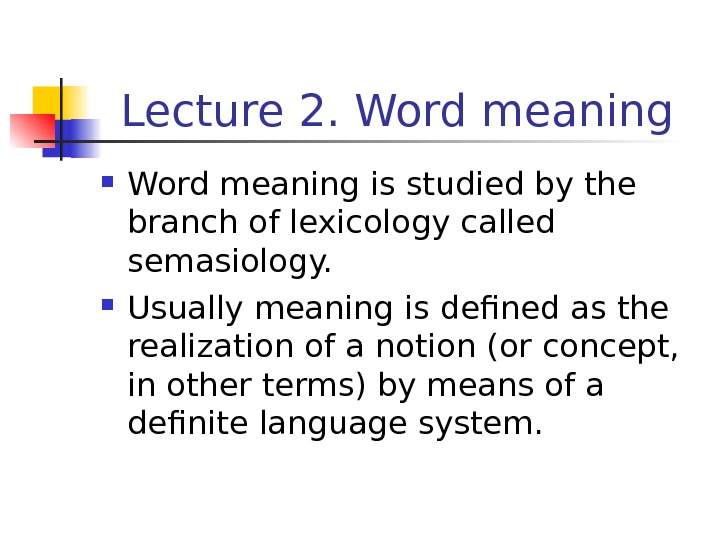
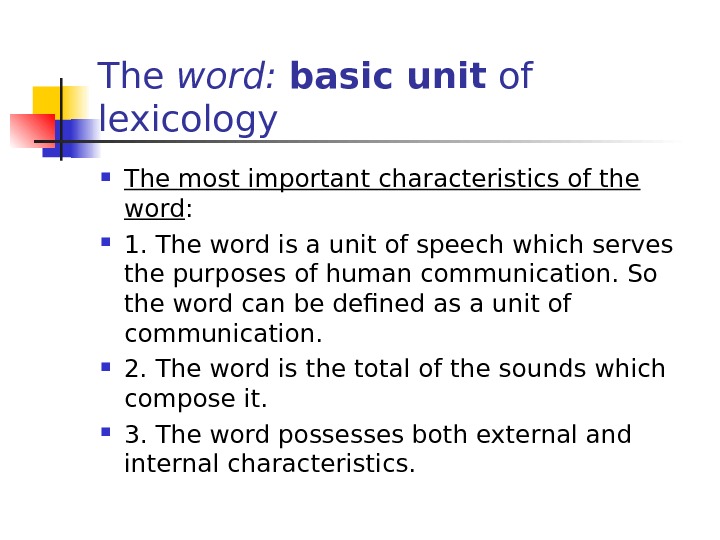
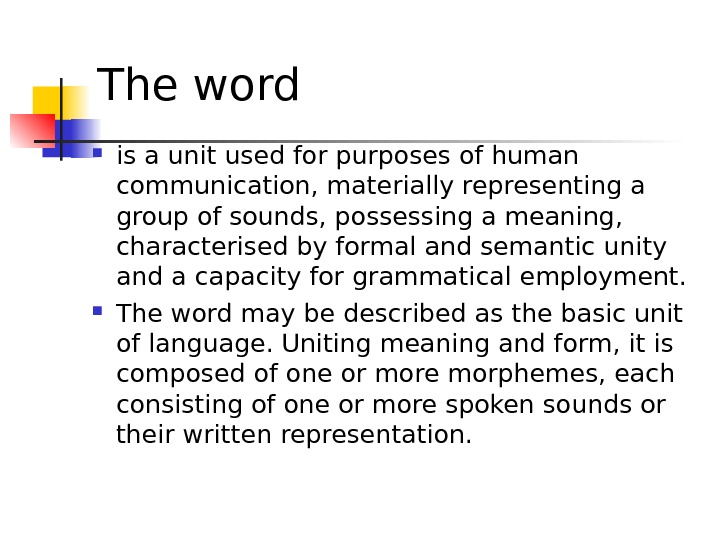
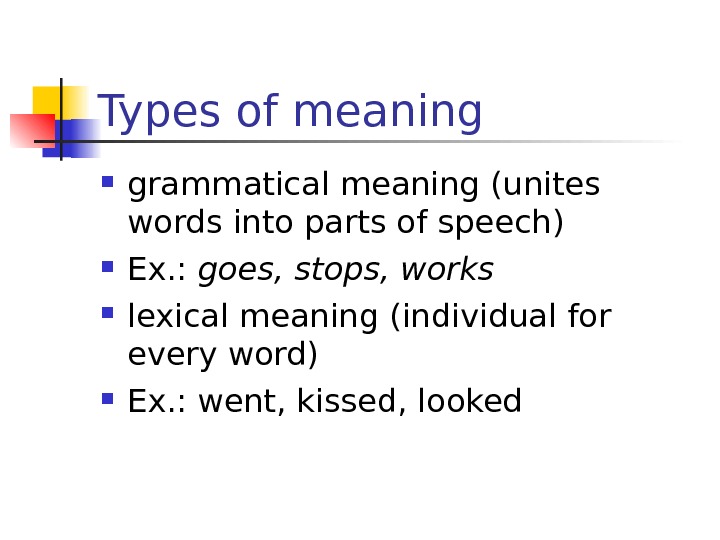
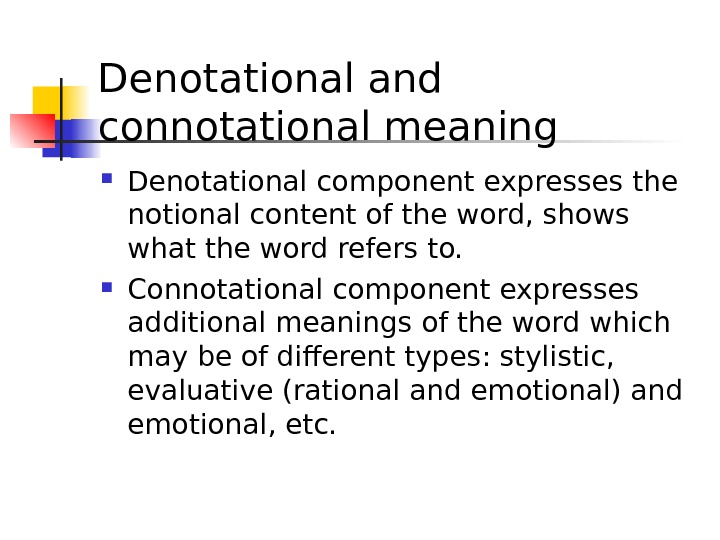


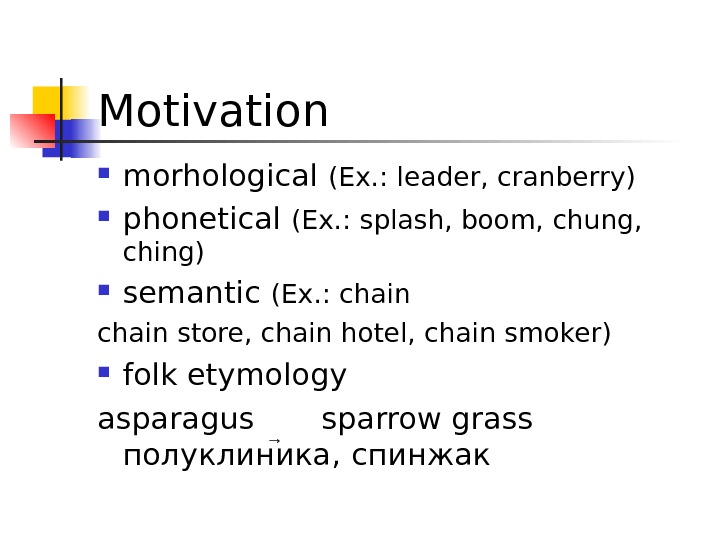

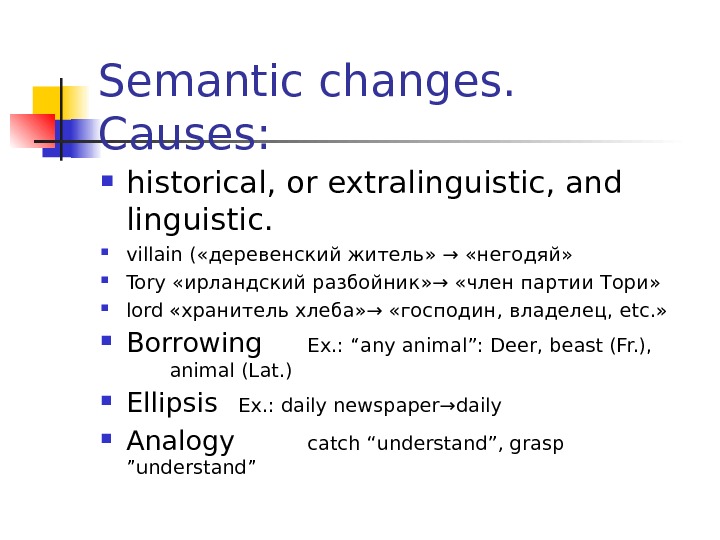
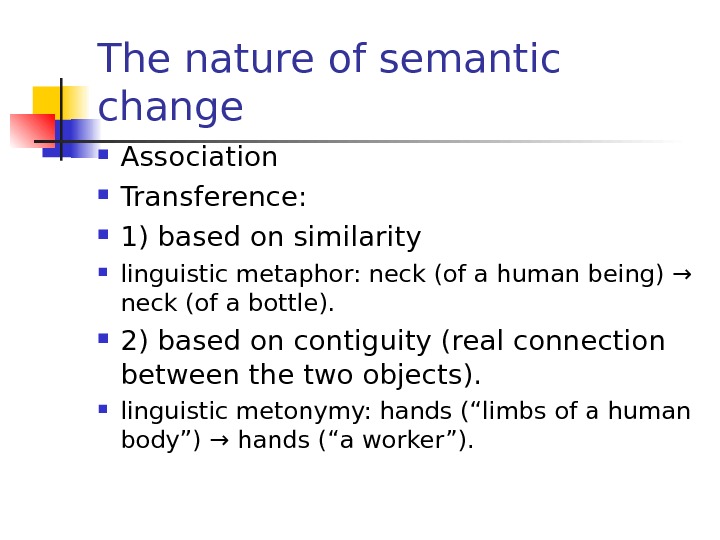
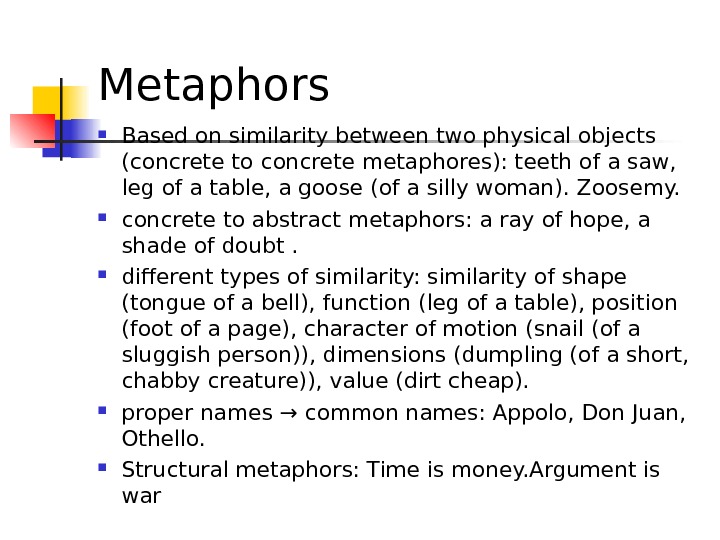



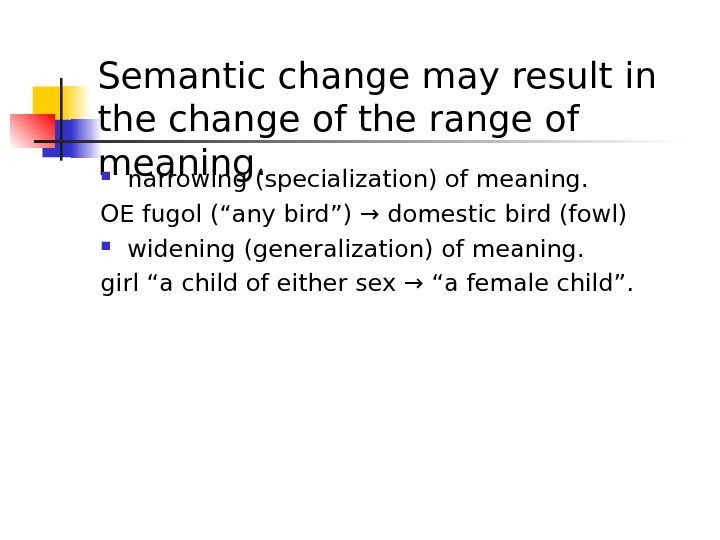
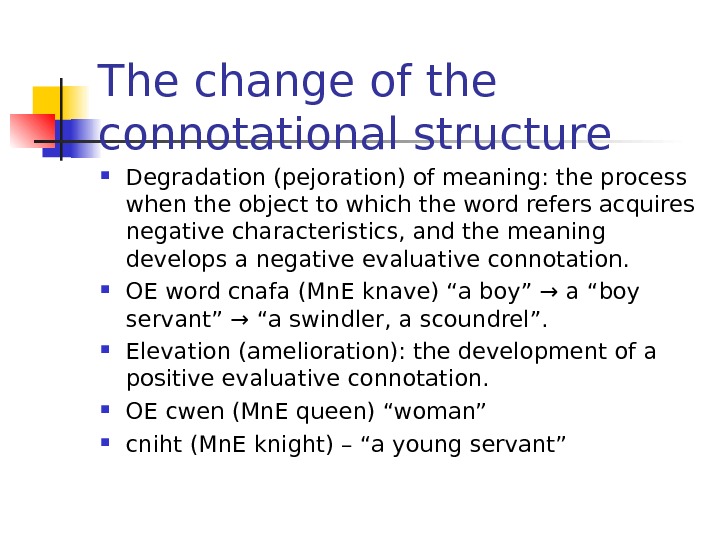
1. Word Meaning
1. Two schools of thought.
2. Denotation and connotation. Types of
connotation.
3. Polysemy.
4. Semantic changes (metaphor,
metonymy, narrowing /specialization,
broadening /generalization).
5. Secondary ways of semantic change.
2.
• The term semasiology comes from Greek
sema «sign» + semantikos «significant»
• It was introduced into linguistic studies in
1825 by the classical scholar C. Reisig
who set up a new division of grammar
(semasiology, etymology and syntax).
• He regarded semasiology as a historical
discipline that should establish the
principles of governing the
development of meaning.
3.
• In 1883 Michel Breal (the French
philologist) published an article in which
he argued that there ought to be a
science of meaning which he proposed
to call semasiology.
• In 1897 he published his book which
soon spread to other languages and in
1900 after its publication was translated
into English under the title: Semantics:
Studies in the Science of Meaning.
4.
• Another famous book on semantics is The
meaning of meaning by С. К. Ogden and I. A.
Richards published in 1923.
• The term semantics was first used to refer to
the development and change of meaning. It
is originated from Greek word «semantikos»
(«significant“).
• It is the study of meanings – dealing with the
relationship between symbols (words, signs,
etc.) and what they refer to (‘referents’) – and
of behavior in reaction to non-verbal
symbols and verbal symbols (words).
5. Two schools of thought
• relative or
functional
approach
• denotational or
referential
approach
• The relative approach is based on treating the
language as a semiotic system – the theory of
relations .
• The denotational trend of semantic studies
considers a word as a unit possessing its own
meaning.
6. Relative approach
• Each sign achieves a meaning only in
comparison with other signs, its neighbours:
meaning can be studied only through context.
CONTEXT
Extra-linguistic
Linguistic
Lexical
Grammatical
Mixed
7. Referential approach
• The main problem is the relation
between the word, its meaning and the
object in reality which it denotes.
• The basis of the denotational theory is
the double nature (ideal and material) of
the word.
• The material side of the word (symbol),
its meaning, and the referent are
connected with one another.
8.
• The meaning of a word is the reflection of the
objective reality in our consciousness.
Concept-notion
Linguistic sign
Referent
• The word is a form of a notion’s material
existence.
9.
• Every word has two aspects: the outer
aspect (its sound form) and the inner
aspect (its meaning).
• The lexical meaning of a word is the
realization of a notion by means of a
definite language system.
• A word is a language unit, while a
notion is a unit of thinking.
• A notion denotes the reflection in the
mind of real objects and phenomena in
their essential features and relations.
10.
• Notions, as a rule, are international.
• Meanings can be nationally limited.
• The development of lexical
meanings in any language, as well
as the grouping of meanings in
the semantic structure of a word, is
determined by the whole system
of every language.
11.
• Word meaning is made up of various
components. There are 2 important elements
of the meaning:
denotation
connotation
• the denotational – the realization of the notion
(which makes communication possible) and
the connotational – the pragmatic
communicative value of the word.
12.
• The denotation of a word is the direct
explicit meaning that makes
communication possible.
• When we say that a word denotes
something, we mean that it is the name
of a thing.
• To denote is to serve as a linguistic
expression for a concept.
• The conceptual content of a word is
expressed in its denotative meaning.
13.
• The connotation of a word is what the word
implies in addition to its denotational meaning.
It is the set of associations that a word’s use
can evoke:
• a hovel denotes «a small house» and besides
implies that it is a miserable dwelling place,
dirty, in bad repair, and, in general, unpleasant
to live in.
• We call connotation what the word conveys
about the speaker’s attitude to the social
circumstances and the appropriate functional
style, about his approval or disapproval of the
object spoken, or the degree of intensity.
14.
There are 4 main types of connotation:
stylistic (to beat it – to retire, horse –
steed),
emotive (dog – doggie),
evaluative (famous/ well-known –
notorious), and
expressive or intensifying (splendid,
superb, fantastic, beastly, etc. are used
colloquially as terms of exaggeration).
We can also speak of pragmatic
connotations, i.e., those of duration,
manner, attending circumstances, etc.
15.
• The connotation is the idea suggested by its
place near /in association with other words or
phrases.
• Childlike and childish both have the
denotation of «like or characteristic of a
child». However the two words have their own
connotations.
• Childlike suggests the favourable qualities
considered typical of a child: innocence and
trustworthiness.
• Childish connotes the unfavourable
characteristics of a child: foolishness or
immaturity.
16.
• The context of the word can also help to
reveal the general and added meanings.
The context is the part of the statement in
which the word or passage at issue
occurs, that which leads up to and follows
a particular expression:
• The actress captured perfectly the
character’s childlike qualities in her
performance.
• Your childish behaviour is quite
annoying in a grown person.
17.
• Denotative and connotative
components make up the semantic
structure (or semantic paradigm) of a
word which is presented by a structure
of semes.
• A seme is the smallest unit of
meaning.
• Thus, the meaning of the word giggle
includes semes of action, living
being and sex, negative evaluation
and intensity.
18.
• KEY TERMS: semasiology, semantics,
relative, referential, denotation,
connotation, seme.
• Антрушина Г.Б., Афанасьева О.В.,
Морозова Н.Н. Лексикология
английского языка. – стр. 147-151; 193197.
• Елисеева В.В. Лексикология
английского языка.
Слайд 1Word Meaning
Two schools of thought.
Denotation and connotation. Types of connotation.
Polysemy.
Semantic
changes (metaphor, metonymy, narrowing /specialization, broadening /generalization).
Secondary ways of semantic change.
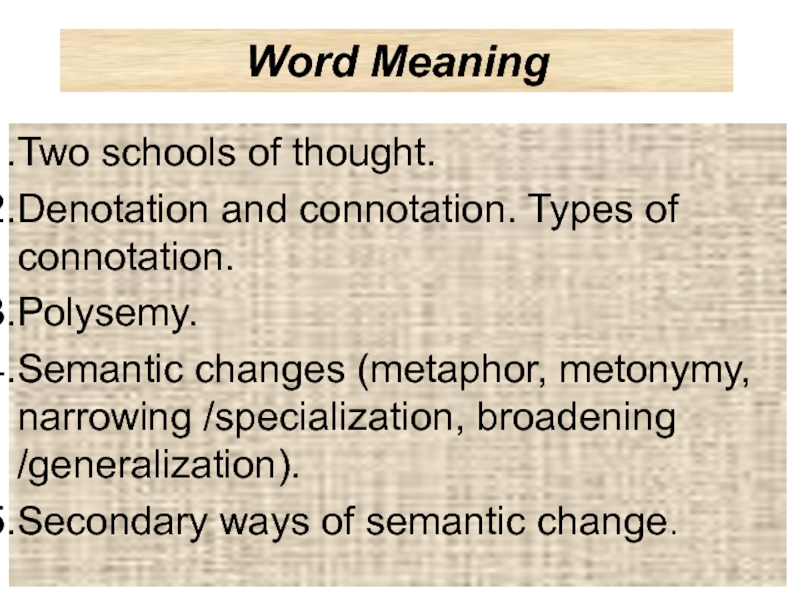
Слайд 2The term semasiology comes from Greek sema «sign» + semantikos «significant»
It was introduced into linguistic studies in 1825 by the classical scholar C. Reisig who set up a new division of grammar (semasiology, etymology and syntax).
He regarded semasiology as a historical discipline that should establish the principles of governing the development of meaning.
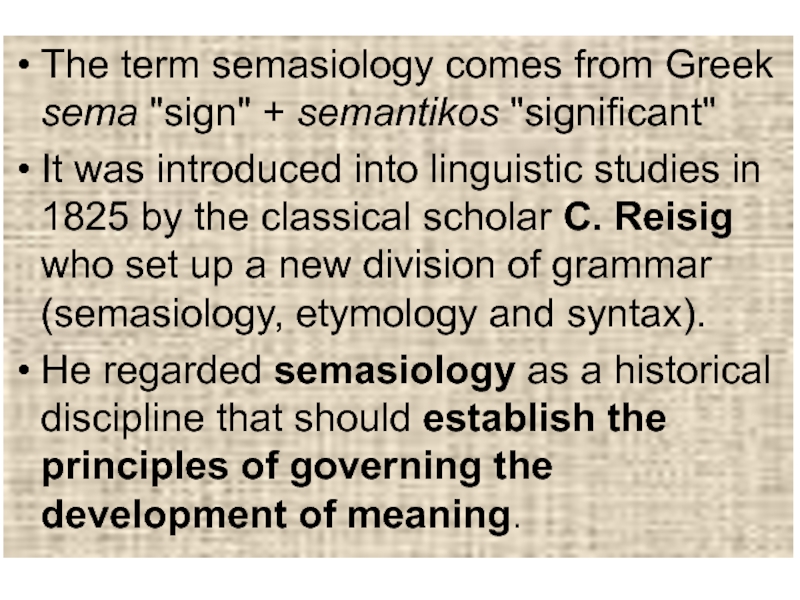
Слайд 3In 1883 Michel Breal (the French philologist) published an article in
which he argued that there ought to be a science of meaning which he proposed to call semasiology.
In 1897 he published his book which soon spread to other languages and in 1900 after its publication was translated into English under the title: Semantics: Studies in the Science of Meaning.
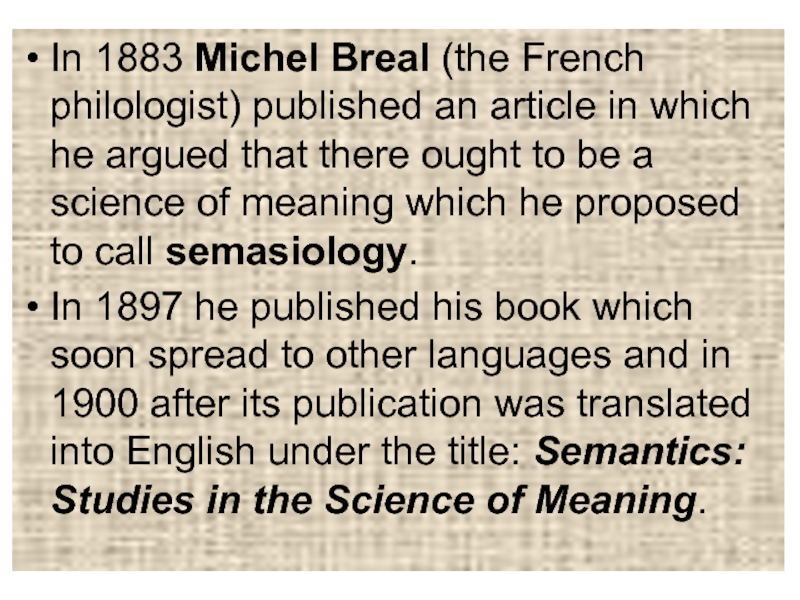
Слайд 4Another famous book on semantics is The meaning of meaning by
С. К. Ogden and I. A. Richards published in 1923.
The term semantics was first used to refer to the development and change of meaning. It is originated from Greek word «semantikos» («significant“).
It is the study of meanings – dealing with the relationship between symbols (words, signs, etc.) and what they refer to (‘referents’) – and of behavior in reaction to non-verbal symbols and verbal symbols (words).
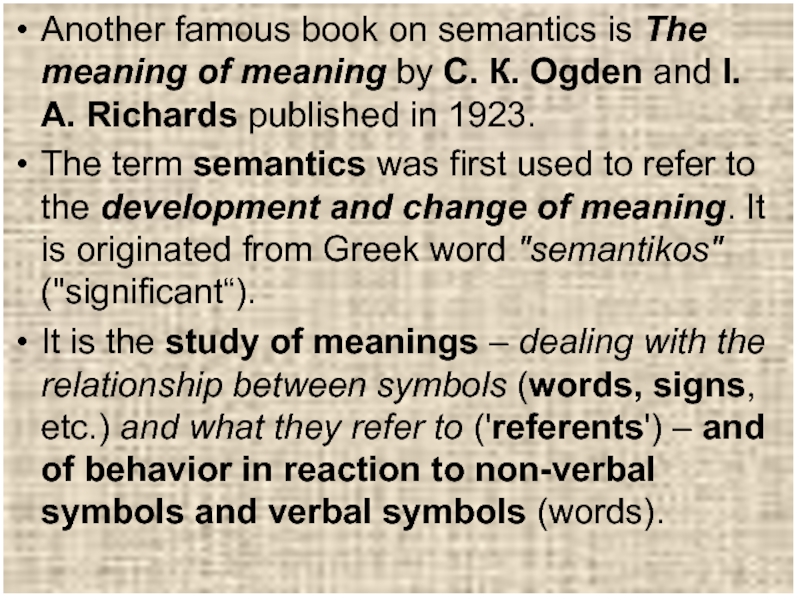
Слайд 5Two schools of thought
relative or functional approach
denotational or referential approach
The relative approach is based on treating the language as a semiotic system – the theory of relations .
The denotational trend of semantic studies considers a word as a unit possessing its own meaning.
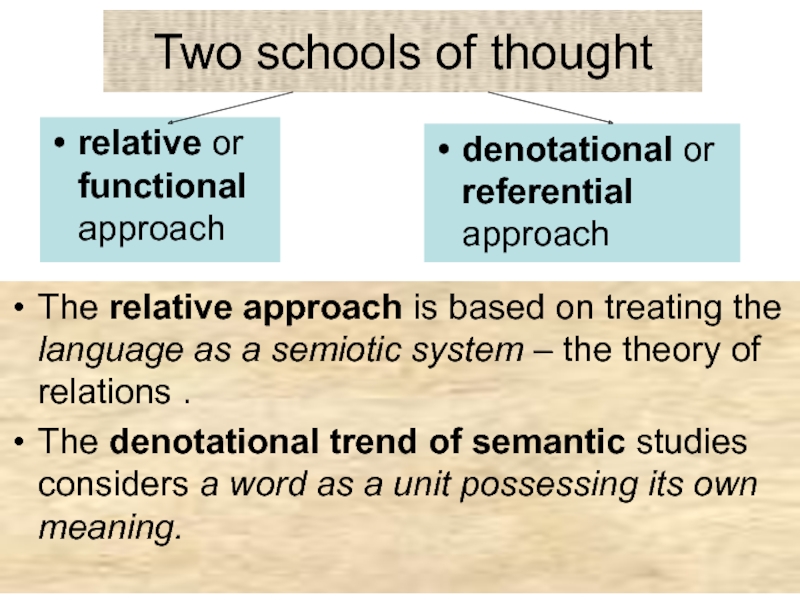
Слайд 6Relative approach
Each sign achieves a meaning only in comparison with other
signs, its neighbours: meaning can be studied only through context.
CONTEXT
Extra-linguistic Linguistic
Lexical Grammatical
Mixed
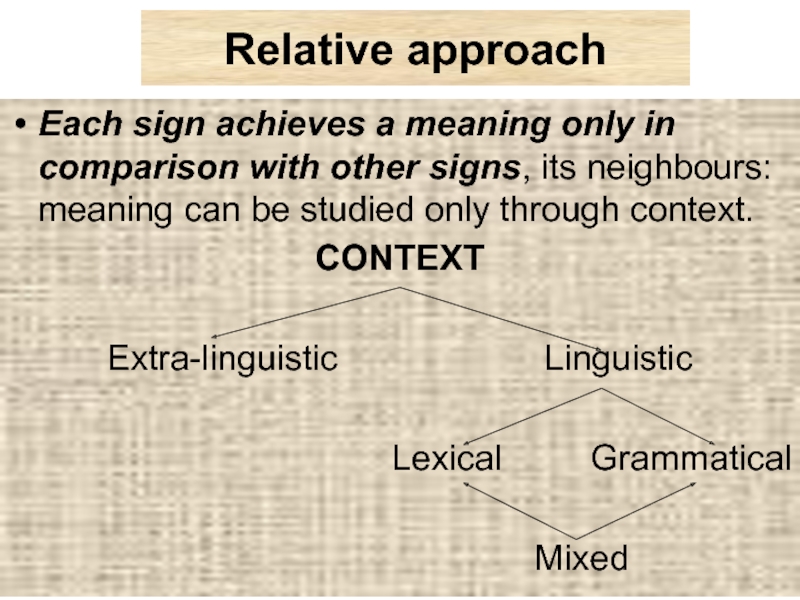
Слайд 7Referential approach
The main problem is the relation between the word,
its meaning and the object in reality which it denotes.
The basis of the denotational theory is the double nature (ideal and material) of the word.
The material side of the word (symbol), its meaning, and the referent are connected with one another.
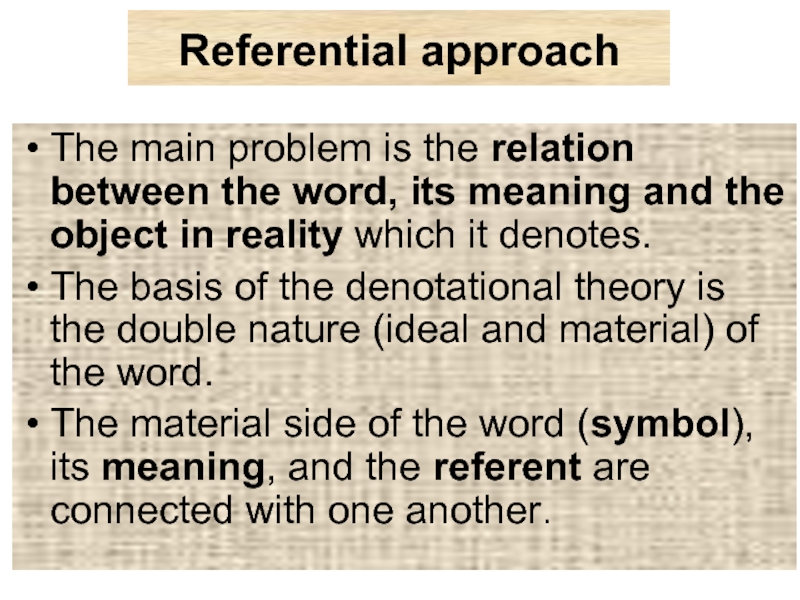
Слайд 8The meaning of a word is the reflection of the objective
reality in our consciousness.
Concept-notion
Linguistic sign Referent
The word is a form of a notion’s material existence.
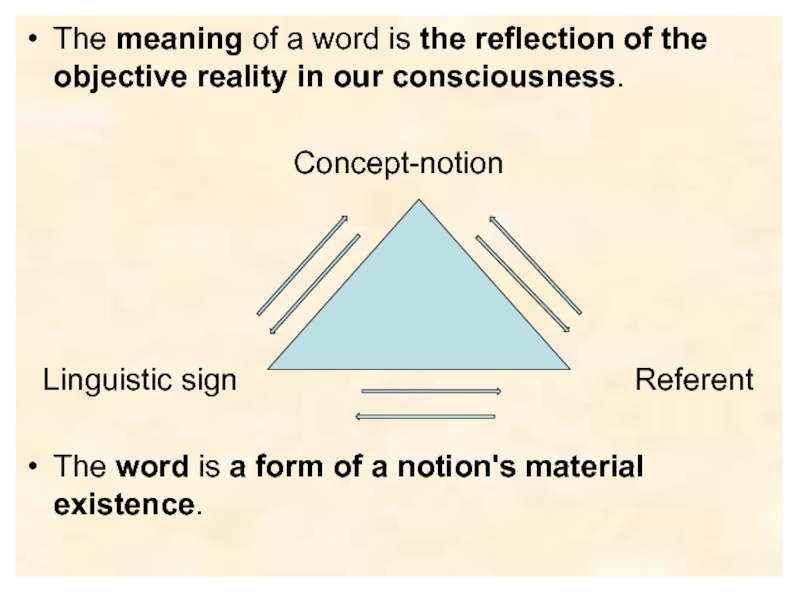
Слайд 9Every word has two aspects: the outer aspect (its sound form)
and the inner aspect (its meaning).
The lexical meaning of a word is the realization of a notion by means of a definite language system.
A word is a language unit, while a notion is a unit of thinking.
A notion denotes the reflection in the mind of real objects and phenomena in their essential features and relations.
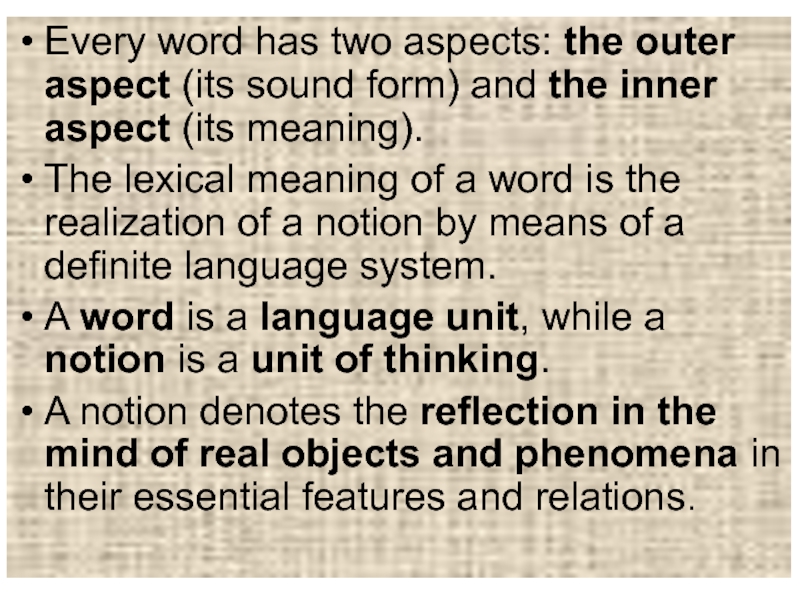
Слайд 10Notions, as a rule, are international.
Meanings can be nationally limited.
The development of lexical meanings in any language, as well as the grouping of meanings in the semantic structure of a word, is determined by the whole system of every language.
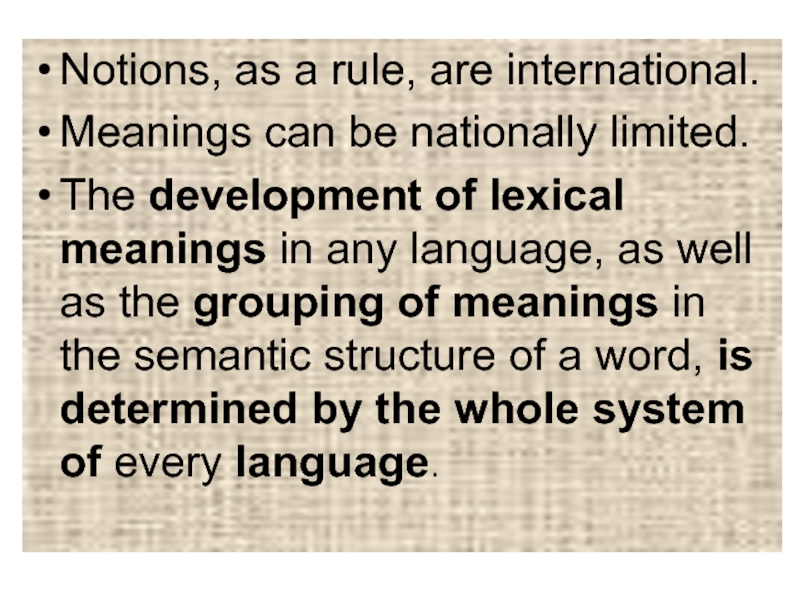
Слайд 11
Word meaning is made up of various components. There are 2
important elements of the meaning:
the denotational – the realization of the notion (which makes communication possible) and the connotational – the pragmatic communicative value of the word.
denotation
connotation
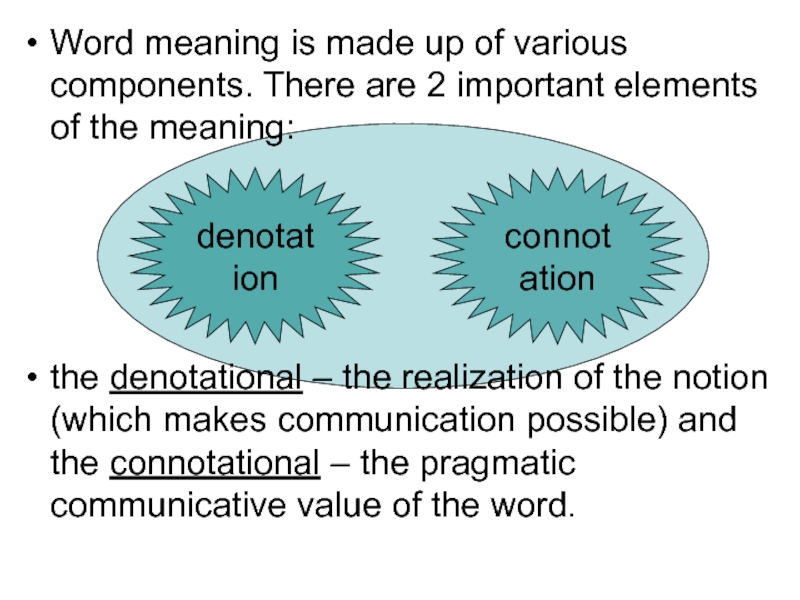
Слайд 12The denotation of a word is the direct explicit meaning that
makes communication possible.
When we say that a word denotes something, we mean that it is the name of a thing.
To denote is to serve as a linguistic expression for a concept.
The conceptual content of a word is expressed in its denotative meaning.
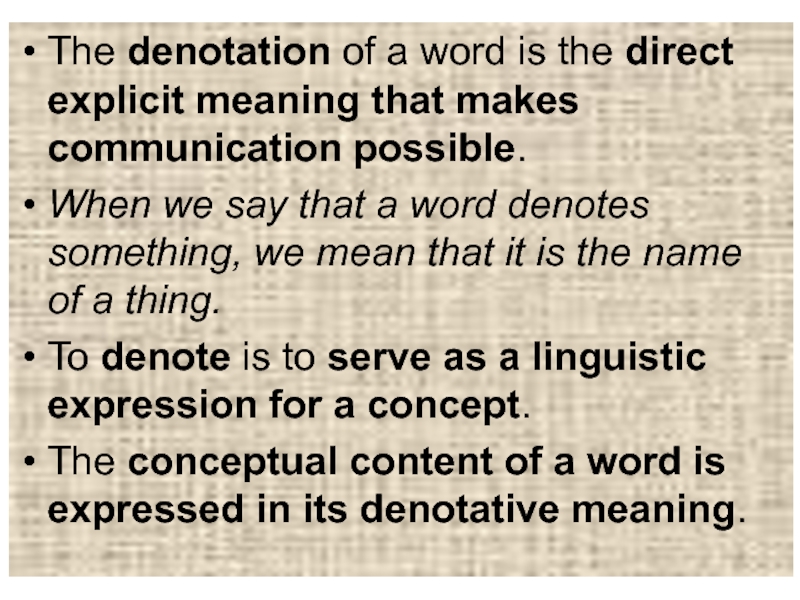
Слайд 13The connotation of a word is what the word implies in
addition to its denotational meaning. It is the set of associations that a word’s use can evoke:
a hovel denotes «a small house» and besides implies that it is a miserable dwelling place, dirty, in bad repair, and, in general, unpleasant to live in.
We call connotation what the word conveys about the speaker’s attitude to the social circumstances and the appropriate functional style, about his approval or disapproval of the object spoken, or the degree of intensity.
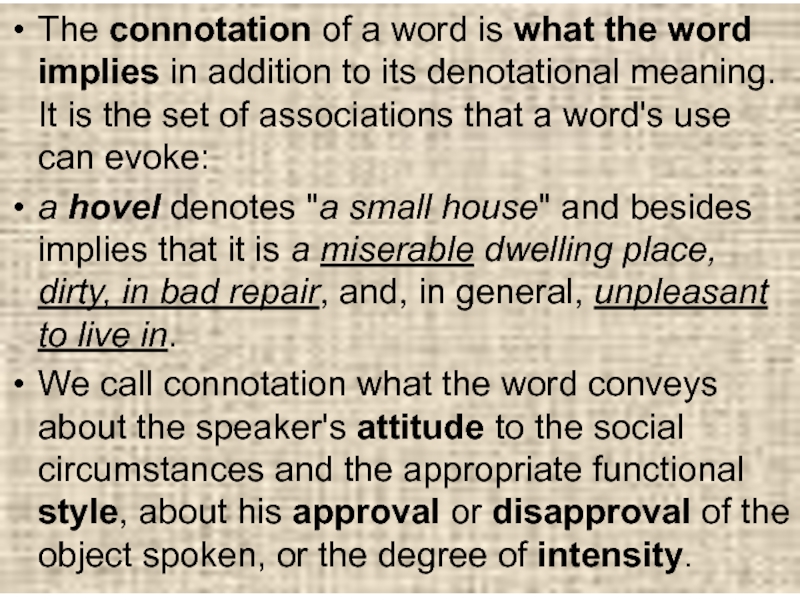
Слайд 14 There are 4 main types of connotation:
stylistic (to beat it –
to retire, horse – steed),
emotive (dog – doggie),
evaluative (famous/ well-known – notorious), and
expressive or intensifying (splendid, superb, fantastic, beastly, etc. are used colloquially as terms of exaggeration).
We can also speak of pragmatic connotations, i.e., those of duration, manner, attending circumstances, etc.
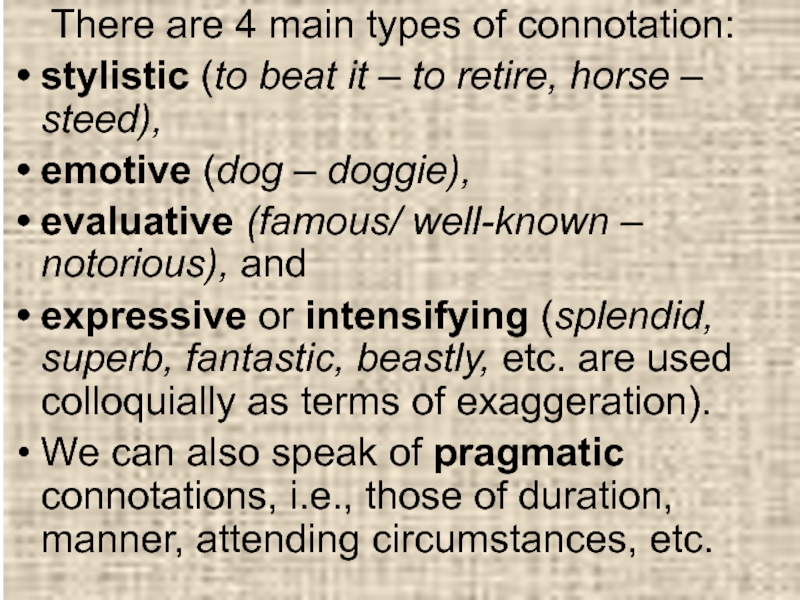
Слайд 15The connotation is the idea suggested by its place near /in
association with other words or phrases.
Childlike and childish both have the denotation of «like or characteristic of a child». However the two words have their own connotations.
Childlike suggests the favourable qualities considered typical of a child: innocence and trustworthiness.
Childish connotes the unfavourable characteristics of a child: foolishness or immaturity.
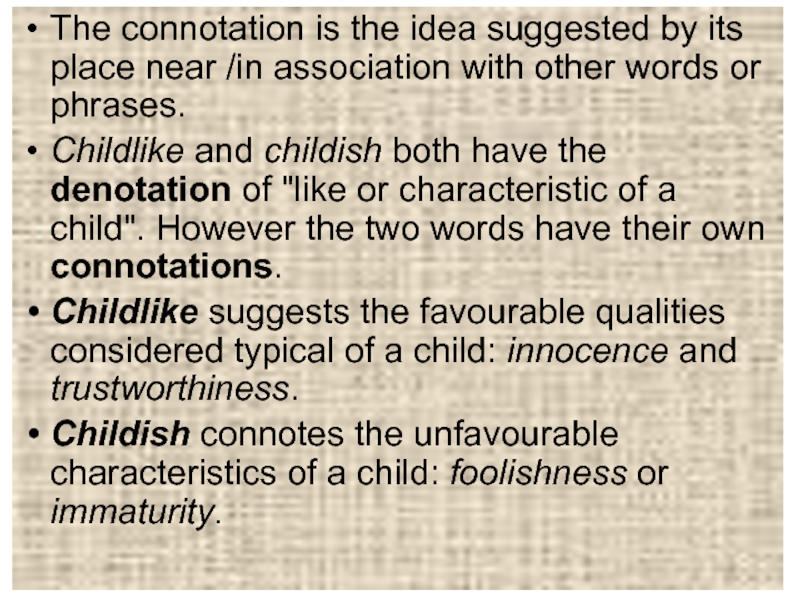
Слайд 16The context of the word can also help to reveal the
general and added meanings. The context is the part of the statement in which the word or passage at issue occurs, that which leads up to and follows a particular expression:
The actress captured perfectly the character’s childlike qualities in her performance.
Your childish behaviour is quite annoying in a grown person.
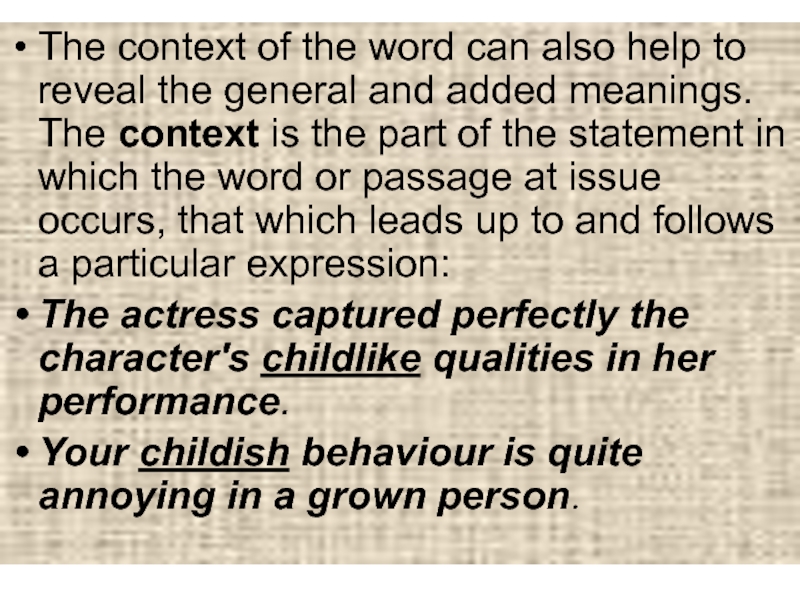
Слайд 17Denotative and connotative components make up the semantic structure (or semantic
paradigm) of a word which is presented by a structure of semes.
A seme is the smallest unit of meaning.
Thus, the meaning of the word giggle includes semes of action, living being and sex, negative evaluation and intensity.
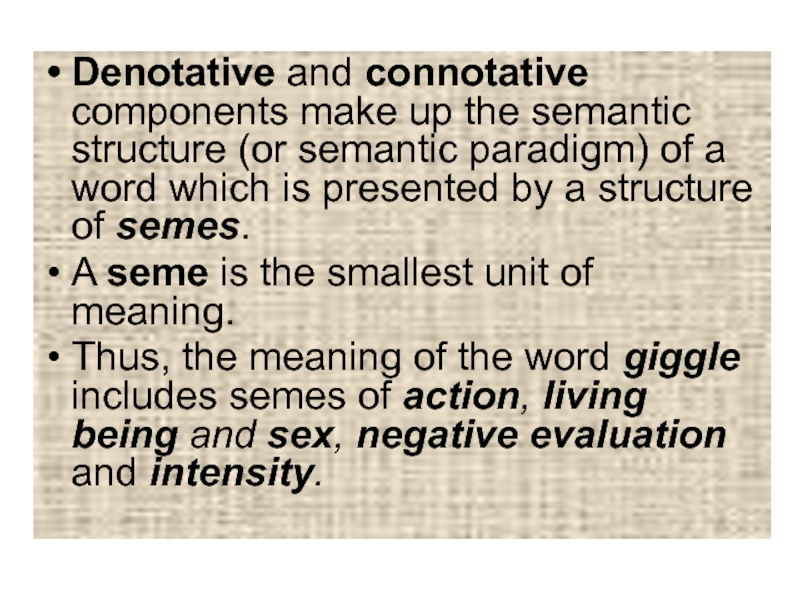
Слайд 18KEY TERMS: semasiology, semantics, relative, referential, denotation, connotation, seme.
Антрушина Г.Б., Афанасьева
О.В., Морозова Н.Н. Лексикология английского языка. – стр. 147-151; 193-197.
Елисеева В.В. Лексикология английского языка.
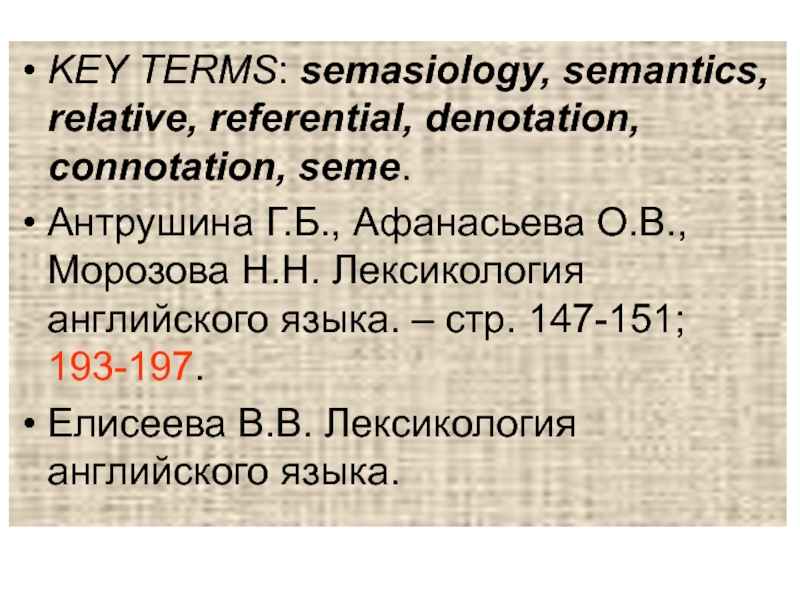









![Meaning and Sound-formare not identical
different
EX. dove - [dΛv]... Meaning and Sound-formare not identical
different
EX. dove - [dΛv]...](https://documents.infourok.ru/2d0c9b9d-1c12-4da2-8c1e-80496902c301/slide_10.jpg)









































